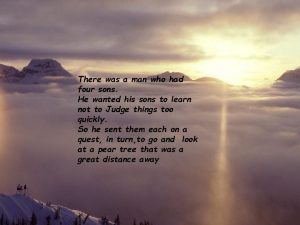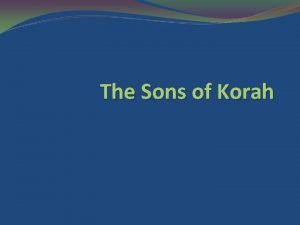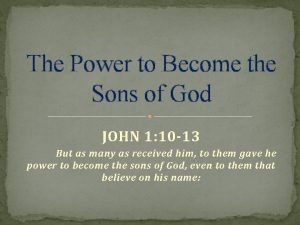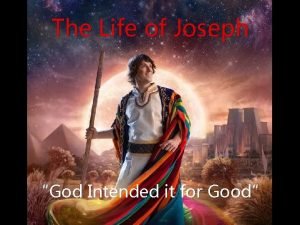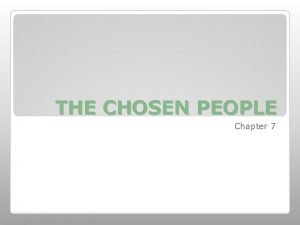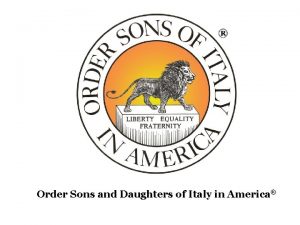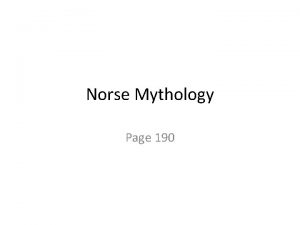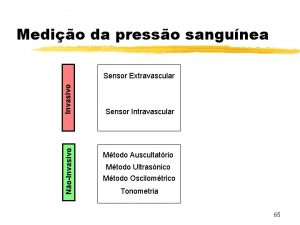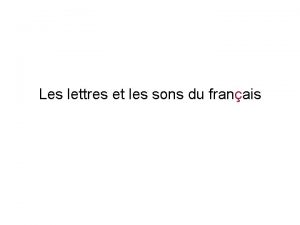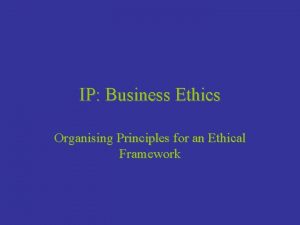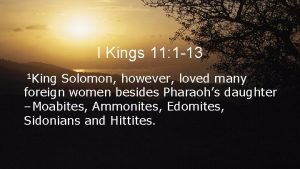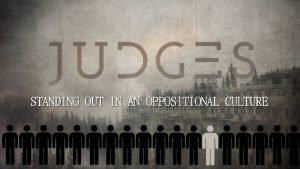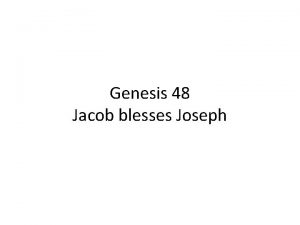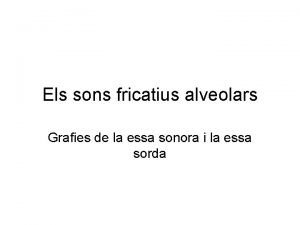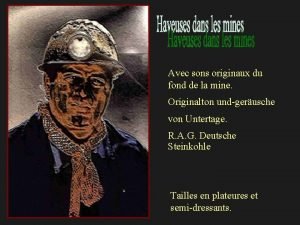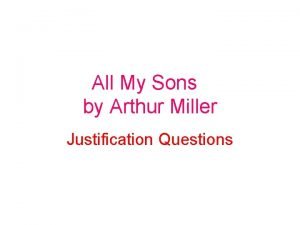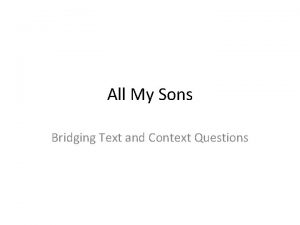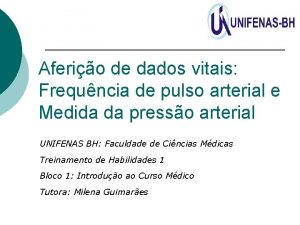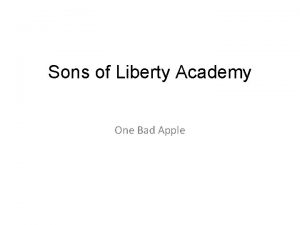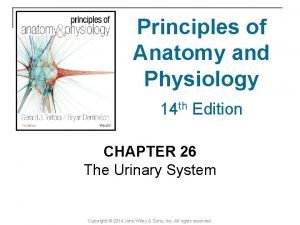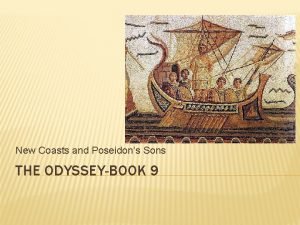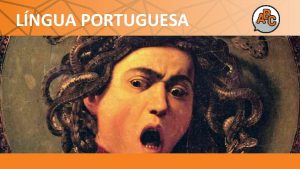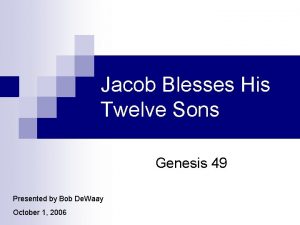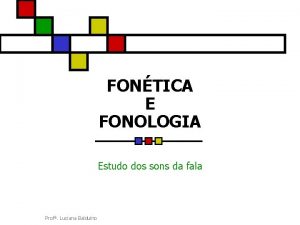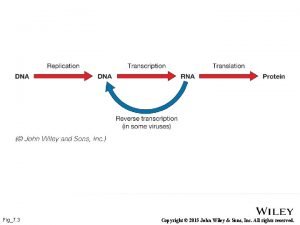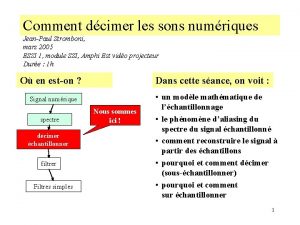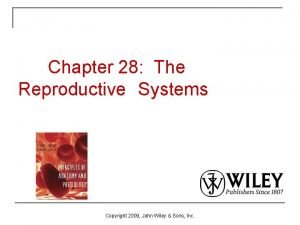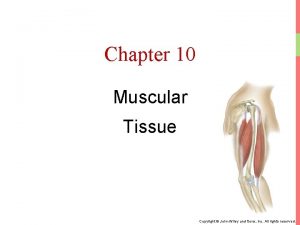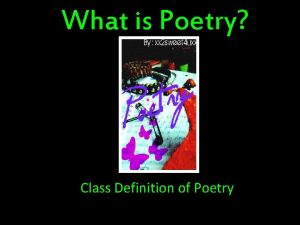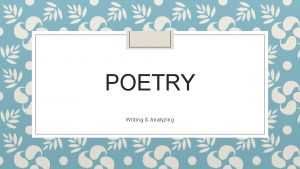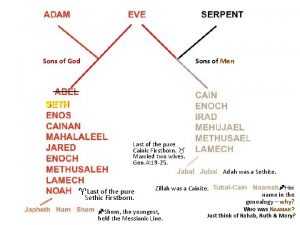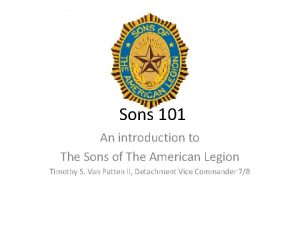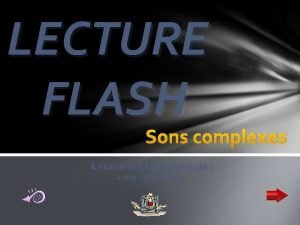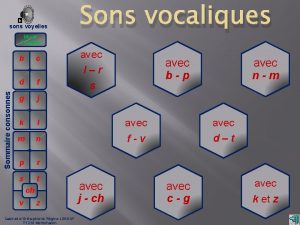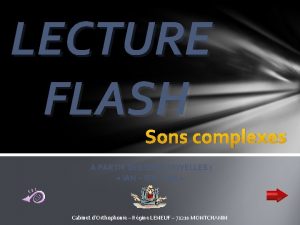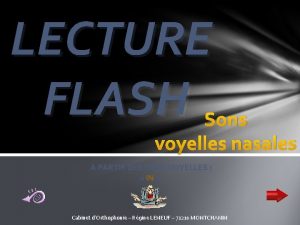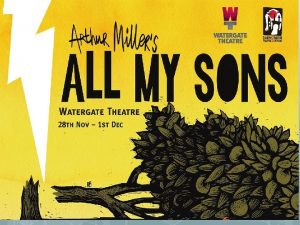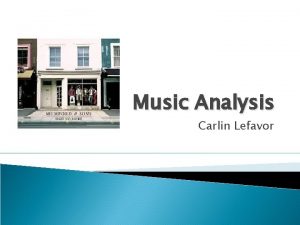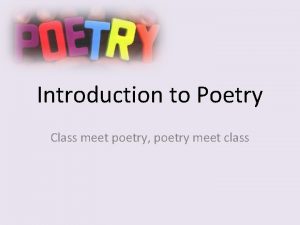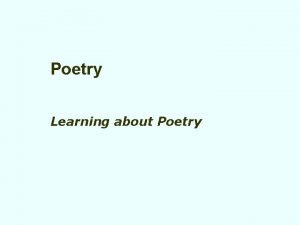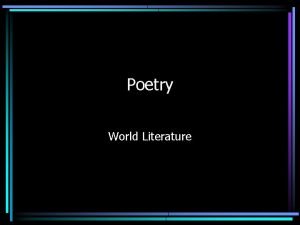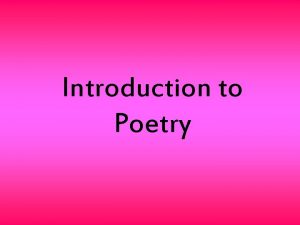What is Poetry Class Definition of Poetry Sons








































- Slides: 40

What is Poetry? Class Definition of Poetry

Sons of Poetry • Link for Sons of Poetry • http: //www. youtube. com/watch? v=Fm. ICU 1 g MAAw

Appreciating Poetry What makes a song unforgettable? Perhaps it is the rhythm of the music or the catchy lyrics. A song might also speak to you because it reminds you of something in your own life. Like a song, a poem can capture your imagination with what it says and how it sounds.

Song or Poem … Could it Be Both? Listen to Adele’s song: “Set Fire to the Rain” http: //www. youtube. com/watch? v=Fls. BObg-1 BQ Class Discussion: How is this song poetic? What poetic elements are included? How does this song speak to you? Can you relate in any way?

Poetic Form • How does a poem speak to you from the page? Aside from its unique sound, a poem also conveys meaning through its form and its speaker. • FORM is the way a poem’s words and lines are laid out on the page. Lines may or may not be complete sentences and can vary in length.

Poetic Form: • I let it fall, my heart, And as it fell you rose to claim it It was dark and I was over Until you kissed my lips and you saved me My hands, they're strong But my knees were far too weak, To stand in your arms Without falling to your feet But there's a side to you That I never knew, never knew. All the things you'd say They were never true, And the games you play You would always win, always win. • Class Discussion: Using the definition below, discuss the form of the poem. Are all of the lines complete sentences? Discuss the use of white space left from the shorter sentences. What is the purpose? • FORM is the way a poem’s words and lines are laid out on the page. Lines may or may not be complete sentences and can vary in length. •

Poetic Form: Speaker A poem’s personality depends on its speaker as well as its form. The speaker in a poem is the voice that talks to the reader. The speaker may be the poet, or it may be a character created by the poet. Who is the speaker in Adele’s song? Is it Adele or a character she created?

Poetic Form: Lines/Stanza • In some poems, the lines are arranged into groups, called stanzas. Each stanza helps to convey a poem’s overall message. The end of a stanza signifies the end of one thought. • For example: But there's a side to you That I never knew, never knew. All the things you'd say They were never true, And the games you play You would always win, always win. How is a stanza like a paragraph in an essay? Why is it important that all of these lines read together? What is the main idea or overall message of this stanza?

Poetic Form: Traditional Vs. Free Verse Some poems have traditional, or structured forms. Traditional poems follow fixed rules; for instance, they might have a certain number of lines or a repeating pattern of rhythm or rhyme. Poems that do not follow set rules are called free verse.

Poetic Form: Free The following poem “Street Corner Flight” by Verse Norma Flores is written in free verse. Because it has no regular pattern of rhythm or rhyme, the poem sounds like everyday speech. From this side … of their concrete barrio two small boys hold fat white pigeons trapped in their trembling hands. Then gently, not disturbing their powers of flight, release them Into the air.

Types of Poems • There are many different types of poems, but for this unit we will be studying the following: • -Narrative (concentrating on historical context) • -Lyric • -Diamante • -Cinquain • -Haiku (traditional Japanese) • -Sonnet • -Limerick • -Ballad • -Epic • -Ode

Types of Poetry: Narrative 1. Narrative poem – a poem that tells a story. Example: “Little Orphan Annie” by James Whitcomb Riley Little Orphan Annie's come to my house to stay. To wash the cups and saucers up and brush the crumbs away. To shoo the chickens from the porch/dust the hearth and sweep, And make the fire/bake the bread to earn her board and keep. While all us other children, when the supper things is done, We sit around the kitchen fire and has the mostest fun, A listening to the witch tales that Annie tells about And the goblins will get ya if ya don't watch out!

Types of Poetry: Lyric Poetry 2. Lyric – a short poem in which a single speaker expresses personal thoughts and feelings. Lyric poems cover many subjects, from love and death to everyday experiences. For example: I thought the earth remembered me, she took me back so tenderly, arranging her dark skirts, her pockets full of lichens and seeds.

Types of Poetry: Diamante 3. Diamante - A diamante is a seven line poem, shaped like a diamond that describes opposites. square symmetrical, conventional shaping, measuring, balancing boxes, rooms, clocks, halos circling, turning, orbiting round, continuous circle

Diamante Format • Line 1: one word (subject/noun that is contrasting to line 7) • Line 2: two words (adjectives) that describe line 1 • Line 3: three words (action verbs) that relate to line 1 • Line 4: four words (nouns) first 2 words relate to line 1; last 2 words relate to line 7 • Line 5: three words (action verbs) that relate to line 7 • Line 6: two words (adjectives) that describe line 7 • Line 7: one word ( subject/noun that is contrasting to line 1)

Types of Poetry: Cinquain 5. Cinquain - A five line poem which consists of 1 noun, 2 adjectives, 3 “ing” words, 4 feeling words, and a synonym for the noun. The first line is just one word, which is often the title of the poem. The second line has two words which describe the first line. The third line has three words, and is mostly the action part of the poem. The fourth line is four words describing the feelings. And the fifth line, again, has just one word which is the title of the poem.

Cinquain Pattern • • • Line 1: A noun Line 2: Two adjectives Line 3: Three -ing words Line 4: A phrase Line 5: Another word for the noun

Cinquain Example Knights Armour , shields Fighting, charging, slaughtering Worried, delighted, brave, fearsome Crusaders

Types of Poetry: Haiku 4. Haiku – a form of poetry that originated hundreds of years ago in Japan. In a haiku, poets seek to create a clear picture with few words. A haiku centers on a symbol that instantly reminds its reader of a season. You must use symbols and imagery and pay attention to syllables and line count. The entire poem consists of just 17 syllables arranged in three lines. The first and third lines each contain five syllables, and the second line has 7 syllables.

Haiku Example On sweet plum blossoms The sun rises suddenly. Look, a mountain path!

Types of Poetry: Sonnet 6. Sonnet- This type of poem contains fourteen lines, each line containing ten syllables, and follows the traditional rhyme scheme. Read Shakespeare’s Sonnet 18 while listening to the song: http: //www. youtube. com/watch? v=S 8 Osse 7 w 9 fs&list=RDhr. Fyv. B 6 Nm pcle

Sonnet 18 • Shall I compare thee to a summer's day? Thou art more lovely and more temperate: Rough winds do shake the darling buds of May, And summer's lease hath all too short a date: Sometime too hot the eye of heaven shines, And often is his gold complexion dimm'd; And every fair from fair sometime declines, By chance, or nature's changing course, untrimm'd; But thy eternal summer shall not fade Nor lose possession of that fair thou ow'st; Nor shall Death brag thou wander'st in his shade, When in eternal lines to time thou grow'st; So long as men can breathe or eyes can see, So long lives this, and this gives life to thee.

Sonnet 18 Paraphrase SONNET 18 PARAPHRASE Shall I compare thee to a summer's day? Shall I compare you to a summer's day? Thou art more lovely and more temperate: You are more lovely and more constant: Rough winds do shake the darling buds of May, Rough winds shake the beloved buds of May And summer's lease hath all too short a date: And summer is far too short: Sometime too hot the eye of heaven shines, At times the sun is too hot, And often is his gold complexion dimm'd; Or often goes behind the clouds; And every fair from fair sometime declines, And everything beautiful sometime will lose its beauty, By chance, or nature's changing course, untrimm'd; By misfortune or by nature's planned out course. But thy eternal summer shall not fade But your youth shall not fade, Nor lose possession of that fair thou ow'st; Nor will you lose the beauty that you possess; Nor shall Death brag thou wander'st in his shade, Nor will death claim you for his own, When in eternal lines to time thou grow'st; Because in my eternal verse you will live forever. So long as men can breathe or eyes can see, So long as there are people on this earth, So long lives this and this gives life to thee. So long will this poem live on, making you immortal.

Types of Poetry: Limerick 7. Limerick - The standard form is a stanza of five lines, with the first, second and fifth usually rhyming with one another. The first line traditionally introduces a person and a place, with the place appearing at the end of the first line and establishing the rhyme scheme for the second and fifth lines.

Limerick Example There was a young person of Smyrna (Smurna) Whose grandmother threatened to burn her; But she seized on the cat, and said, “Granny, burn that! You incongruous old woman of Smyrna!” Listen to the Limerick Song: http: //www. bing. com/videos/search? q=Limerick+song&FORM=VIRE 1#view=detail&mid=04 A 2 F 3 A 4 FE 196 D 8 E 605 E 04 A 2 F 3 A 4 FE 196 D 8 E 605 E

Types of Poetry: Ballad 8. Ballad - a narrative folk song or poem. Its distinctive style began in Europe in the late Middle Ages as part of the oral tradition, and it has been preserved as a musical and literary form. The folk ballad typically tells a compact tale with deliberate starkness, using devices such as repetition to heighten effects. Turn to page 638 in lit. book and read “Boots of Spanish Leather. ” Listen to Bob Dylan singing the folk song: http: //www. bing. com/videos/search? q=The+Boots+of+Spanish+Leather+Son g&FORM=VIRE 3#view=detail&mid=BE 4005676 A 94 CCAFA 740 BE 4005676 A 94 C CAFA 740 Did listening to the song help you to understand the poem any better? Does it give density to the poem?

Types of Poetry: Epic • A very long narrative poem about a hero with superhuman abilities who goes through trials to overcome some obstacle. • Example: “The Song of Hiawatha” p. 640 Lit. • Listen to song: http: //www. bing. com/videos/search? q=Song+Of+Hiawatha+1997&Form=VQFRVP#vie w=detail&mid=5 E 390 FF 55 E 6680 A 59561 • • Pay attention to the rhythm and meter. Hint: Drum it out on your desk. In what way does the rhythm Longfellow uses relate to the musical culture of Native Americans?

Types of Poetry: Ode • A lengthy lyrical poem, usually rhymed, praising an object, person, or quality. Greek odes were originally poetic pieces accompanied by symphonic orchestras. • Form groups of two – four and read the poem paraphrasing each stanza. Pay attention to word choice and discuss in relation to theme. How can you identify this poem as an ode? (handout) • “Ode on Solitude” by Alexander Pope on p. 622 in literature book. ‘O Captain, My Captain is also an example of an Ode.

Poetic Devices • There a multitude of poetic devices, but for this unit we will concentrate on the three categories below: • Sound Devices • Figurative Language • Word Choice / Imagery

Poetic Devices: Sound Alliteration/Assonance 1. Alliteration – repetition of beginning consonant sounds. Example: fabulous feast, big bad bear, lazy lizard. 2. Assonance – the repetition of vowel sounds Example: “e” sound in “can ever dissever

Poetic Devices: Sound Onomatopoeia 3. Onomatopoeia – words whose sounds resemble that which is being described. Example: “hiss, ” “tinkle, ” “boom. ”

Poetic Devices: Sound – Rhythm and Rhyme 4. Rhythm is the pattern of stressed and unstressed syllables in each line. • Example: p. 578 – “Afternoon on a Hill” 5. Rhyme is the repetition of sounds at the ends of words. • Example: p. 578 - sun and one. 6. Rhyme Scheme is the pattern that the end rhyming words follow. To identify rhyme scheme, assign a letter to each new sound. For example, the stanza "The cat spilled milk/all over my shirt/which happened to be silk/my feelings are hurt" would be labeled ABAB.

Poetic Device: Sound -Repetition 7. Repetition – the use of a word, phrase, line, or sound more than once. • Example: I will be the gladdest thing Under the sun I will touch a hundred flowers And not pick one.

Poetic Devices: Figurative Language - Metaphor 1. Metaphor – compares two unlike things without using the word like or as. Example: The stars were torches in the night. The stars are being compared to torches because of the way they light up the night.

Poetic Devices: Figurative Language Simile 2. Simile – compares two unlike things using the word like or as. Example: The stars flamed like torches. The stars are compared to torches using “like. ”

Poetic Device: Figurative Language: Personification 3. Personification – gives human qualities to an animal, an object, or an idea. Example: Whispering trees, or angrily marching ants

Poetic Device: Symbol 4. Symbol- the use of something to stand for or represent something else • Examples: flag— symbol of freedom; wedding ring— symbol of marriage

Poetic Device: Imagery 9. Imagery – consists of words and phrases that appeal to your senses of sight, hearing, smell, taste, and touch. Poets use imagery not only to vividly describe things, but also to communicate feelings and ideas.

Imagery Example Yesterday, I lay awake in the palm of the night. A soft rain stole in, un-helped by any breeze. The images “palm of the night” and “soft rain” appeal to your senses of sight and touch. These phrases also suggest a sense of troubled thoughtfulness and perhaps a feeling of change.

MLA Works Cited • For your poetry project, you will need a Works Cited Page to give credit for your borrowed poems. • The format is shown below: • Author Title of Poem Title of Book Burns, Robert. "Red, Red Rose. " 100 Best. Editor Publishing City Loved Poems. Ed. Philip Smith. New York: Publisher Copyright Page Medium Dover, 1995. 26. Print.
 There was a man who had four son
There was a man who had four son There were a man who had four sons
There were a man who had four sons There was a man who had four sons
There was a man who had four sons Who were the sons of korah
Who were the sons of korah The power to become the sons of god
The power to become the sons of god Joseph sons blessed by jacob
Joseph sons blessed by jacob The chosen chapter 7
The chosen chapter 7 El mustee and sons
El mustee and sons Powers and sons llc
Powers and sons llc Order sons of italy in america
Order sons of italy in america Page 190
Page 190 Realism in all my sons
Realism in all my sons Korotkoff
Korotkoff Les lettres en français
Les lettres en français Lambini and sons
Lambini and sons 1 kings 11:1-4
1 kings 11:1-4 Abraham
Abraham Did gideon have 71 sons
Did gideon have 71 sons Joseph sons blessed by jacob
Joseph sons blessed by jacob S sorda s sonora
S sorda s sonora Casey and sons
Casey and sons Les sons de la mine
Les sons de la mine American dream all my sons
American dream all my sons How is the title of all my sons justified
How is the title of all my sons justified Sons of text
Sons of text All my sons bridging text and context
All my sons bridging text and context L
L Who was the intended audience
Who was the intended audience He had two sons
He had two sons Sons of liberty academy
Sons of liberty academy Sons korotkoff
Sons korotkoff Wiley and sons
Wiley and sons New coasts and poseidon's son
New coasts and poseidon's son Barroco letras e sons os gêneros digitais
Barroco letras e sons os gêneros digitais The land of the sons
The land of the sons Steinway & sons steinway asia llc.
Steinway & sons steinway asia llc. Estudo dos sons
Estudo dos sons John wiley & sons, incorporated
John wiley & sons, incorporated échantillonner les sons 7 lettres
échantillonner les sons 7 lettres Pudendum
Pudendum John wiley & sons
John wiley & sons

